Non-Destructive Possibilities of Thermal Performance Evaluation of the External Walls
Abstract
:1. Introduction
2. Thermal Resistance Assessment for Building Enclosure Parts
2.1. Calculation Method
- In the case of a new building, when there is a suspicion as to the thermal performance of the materials used when confronted with the design specifications.
- In the case of an existing building, to assess its technical condition or when there is no relevant information in its design documents.
2.2. In Situ Measuring Methods
- Method 1—the temperature-based method (TBM), consisting of measuring air temperatures and the building enclosure’s surface temperatures on both sides.
- Method 2—the heat flow meter method (HFM), consisting of measuring heat flux densities and the surface temperatures of the building enclosure on both sides.
- Method 3—the infrared thermography method (ITM), consisting of measuring air temperatures and the building enclosure’s surface temperatures on both sides (similarly as in Method 1) and performing radiometric measurements on both sides of the building enclosure: this method is precise, but labor-intensive.
2.2.1. Method 1—The Temperature-Based Method (TBM)
2.2.2. Method 2—Heat Flow Meter Method (HFM)
2.2.3. Method 3—Infrared Thermography Method (ITM)
2.3. Surface Thermal Resistances
2.3.1. Simplified Method
2.3.2. Calculation—Surface Temperatures and Air Movement Velocities Are Known
2.3.3. Calculation—Air Temperatures, Surface Temperatures and Heat Flux Density Are Known
3. Materials and Methods
3.1. Tested Elements
3.2. Test Setup
- The warm chamber (on the left side, blue one): capacity 30 m3, internal dimensions 3.0 m × 4.0 m × 2.5 m, temperature range −30–+80 °C and relative humidity range 10–95%.
- The cold chamber (on the right side, grey one): capacity 30 m3, internal dimensions 3.0 m × 4.0 m × 2.5 m, temperature range −40–+85 °C and relative humidity range 10–95%.
- The warm chamber with activated controlled air temperature θi = +20 °C and relative humidity φi = 50%.
- The cold chamber with activated controlled air temperature θe = −10 °C and uncontrolled relative humidity φe in the area of 30%.
- Air temperatures in the chambers by means of Ahlborn FHA646-E1 and FHA646-E1C T/RH (temperature and relative humidity) sensors with an accuracy of ±0.2 °C, in the range of 5–60 °C.
- Air temperature on the warm chamber side with the FLIR P65 thermal imaging camera with an accuracy of ±2 °C or ±2% of the measured value.
- Air movement velocities in the chambers with the help of the Ahlborn FVA935-TH4K2 TA5O anemometer with an accuracy of ±0.04 m/s + 1% of the measured value, in the range of 0.08–2 m/s, and the FVA605-TA5O anemometer with an accuracy of ±1.5% of the measured value, in the range of 0.15–5 m/s.
- Wall surface temperatures by means of class 2 NiCrNi thermocouples with an accuracy of ±2.5 °C or ±0.0075 multiplied by the measured value, in the range of −45–+200 °C, and a FLIR P65 thermal imaging camera on the warm chamber side.
- The density of the heat flux penetrating through the building enclosure with Ahlborn FQA 150–2 m with an accuracy of 5% at 25 °C.
3.3. Analyzed Methods of Determining Thermal Resistance for Selected Walls
- A computational method (Method 0a),
- A computational-measurement method (Method 0b),
- Measurement methods (Methods 1, 2a, 2b, 3a and 3b),
- The source of the building partition parameters used in calculations—Method 0a is based solely on theoretical calculations using tabular material and surface resistance (Rsi and Rse) values, Method 0b supplements such data with calculated surface resistances and the other methods (1–3b) use measured surface resistances.
- The parameters which need to be measured in order to obtain the total thermal resistance value—in Methods 1, 3a and 3b, the result is determined on the basis of only air and wall surface temperature measurements, whereas in Methods 2a and 2b, it is determined using the measured wall surface temperatures and heat flux densities.
- The way the required parameters are measured—in Methods 2a and 2b, thermocouples are used to measure wall surface temperatures and T/RH sensors are used to measure air temperatures, whereas in Methods 3a and 3b, both air and wall surface temperatures on the warm chamber side are measured by a thermal imaging camera.
- The kind of measuring equipment—in Method 2a, universal temperature sensors and heat flux density measuring sensors are used, whereas in Method 2b, a system dedicated to measuring the thermal resistance of building enclosures is used.
- The way of averaging the measured wall surface temperatures—in Method 3a, the surface temperatures measured by a thermal imaging camera are averaged on the basis of three random thermograms obtained from two spot measurements taken on the wall (six measurements in total), whereas in Method 3b, surface temperatures are averaged on the basis of three random thermograms based on the average for a 25 cm × 40 cm area.
3.4. Air and Surface Temperatures from Thermal Imaging Camera (Methods 3a and 3b)
4. Results
4.1. Surface Thermal Resistances on Both Sides of Tested Walls
- In the warm chamber = 0.56 m/s,
- In the cold chamber = 0.13 m/s.
4.2. Air Temperatures in Chambers and Wall Surface Temperatures
4.2.1. Measurements with Thermocouples
4.2.2. Thermograms of Tested Walls
4.3. Heat Flux Density
4.4. Thermal Resistance of Building Enclosures—Comparison of Methods
- Method 0b—5 × the closest results, no farthest results,
- Method 0a—4 × the closest results, 1 × the farthest results,
- Method 3b—4 × the closest results, 2 × the farthest results,
- Method 2b—2 × the closest results, 3 × the farthest results.
- Method 2a—2 × the closest results, 4 × the farthest results.
- Method 3a—1 × the closest results, 4 × the farthest results.
- Method 1—no closest results, 4 × the farthest results.
5. Discussion
- Method 0a—theoretical calculations and resistances according to Table 7, ISO 6946, is quite sufficient, in the authors’ opinion, to evaluate the thermal performance of the building enclosures being designed, since in this case, it is not possible to assess the actual surface thermal resistances (Rsi and Rse) at the building enclosure surface.
- Method 0b—theoretical calculations supplemented with real measurements of air movement velocity at the building enclosure, used to calculate surface thermal resistances, yields total thermal resistances closest to the mean values.
- Method 1—Temperature-based method (TBM), in theory easy and relatively cheap to implement (only temperature sensors and data acquisition devices are needed), in practice turned out to be least accurate; nevertheless, it can still be regarded as acceptable—the mean error amounting to 10.6% and the maximum measurement deviation from mean value RT reaching no more than 23%. The accuracy of this method is most affected by the location of the sensor measuring temperature only in a particular spot, and so there is no certainty that this place of measurement is representative enough for the whole building partition.
- Method 2a—Heat flow meter method (HFM), based on measurements by a large (0.50 m × 0.50 m) heat flux density sensor, requires very good contact with the substrate, which is not always easy to achieve. In the above tests, contact of the sensor with the wall surface was ensured by circumferentially sticking it to the latter with strong tape. However, during several measurements, it was noticed that the sensor would undergo slight deformations under the influence of changes in the air and wall surface temperatures (it would bulge out and deflect from the surface). The conclusion is that a large amount of thermal paste should be used, but this would result in irreversible staining of the building enclosure surface.
- Method 2b—heat flow meter method (HFM), i.e., the use of a dedicated system of two small sets of heat flux density sensors and thermocouples in order to double the measurement of the parameters needed to determine thermal resistance, as the results show, is a slightly better solution—it is much easier to ensure proper constant contact of small (8 cm in diameter) heat flux density sensors with the substrate, using much less thermal paste, but it is still an invasive method.
- Methods 3a and 3b—Infrared thermography method (ITM) yielded qualitatively similar results as the ones yielded by the HFM methods, though Method 3a, based on averages from spot temperature measurements, was slightly more accurate. The great common advantage of the methods is their complete non-invasiveness towards the surface of the tested building enclosure.
- Adhesion of sensors to the building enclosure surface: Even though small heat flux density sensors provide averages from a smaller area, it is definitely easier to attach them stably than in the case of large sensors. They should be attached using, e.g., thermal paste, but in a possibly small amount so that the thermal paste layer does not affect the measurement.
- Thermocouples are precise temperature sensors, but it is important that the cable connecting them with a data logger has damage-resistant insulation. The authors found silicone insulation to be the best as the fiberglass insulation did not perform well in the difficult measurement conditions (the cables would abrade, whereby the measurements would yield incorrect values).
- Air temperature: one can use a thin black sheet of paper to easily measure this temperature by means of an infrared camera, while taking a thermogram of the building enclosure surface.
- Thermographic measurement: if the building enclosures are relatively homogeneous (as in the analyzed cases), both the spot and area measurements of building enclosure surface temperature can be sufficiently accurate for the purpose of determining the thermal resistance of the building enclosure, but if the latter’s material is highly heterogeneous, the area temperature measurement is recommended.
6. Conclusions
Author Contributions
Funding
Institutional Review Board Statement
Informed Consent Statement
Data Availability Statement
Acknowledgments
Conflicts of Interest
References
- Van den Brom, P.; Meijer, A.; Visscher, H. Performance gaps in energy consumption: Household groups and building characteristics. Build. Res. Inf. 2018, 46, 54–70. [Google Scholar] [CrossRef] [Green Version]
- Desogus, G.; Mura, S.; Ricciu, R. Comparing different approaches to in situ measurement of building components thermal resistance. Energy Build. 2011, 43, 2613–2620. [Google Scholar] [CrossRef]
- Ioannou, A.; Itard, L. Energy performance and comfort in residential buildings: Sensitivity for building parameters and occupancy. Energy Build. 2015, 92, 216–233. [Google Scholar] [CrossRef]
- Majcen, D.; Itard, L.; Visscher, H. Actual and theoretical gas consumption in Dutch dwellings: What causes the differences? Energy Policy 2013, 61, 460–471. [Google Scholar] [CrossRef]
- Siviour, J.B.; McIntyre, D.A. U-value meters in theory and practice. Build. Serv. Eng. Res. Technol. 1982, 3, 61–69. [Google Scholar] [CrossRef]
- McIntyre, D.A. In situ measurement of U-values. Build. Serv. Eng. Res. Technol. 1985, 6, 1–6. [Google Scholar] [CrossRef]
- Modera, M.P.; Sherman, M.H.; Sonderegger, R.C. Determining the U-value of a wall from field measurements of heat flux and surface temperatures. In Building Applications of Heat Flux Transducers; ASTP STP 885; American Society for Testing and Materials: Philadelphia, PA, USA, 1985; pp. 203–220. [Google Scholar]
- Teni, M.; Krstic, H.; Kosinski, P. Review and comparison of current experimental approaches for in-situ measurements of building walls thermal transmittance. Energy Build. 2019, 203, 109417. [Google Scholar] [CrossRef]
- Soares, N.; Martins, C.; Gonçalves, M.; Santos, P.; da Silva, L.S.; Costa, J.J. Laboratory and in-situ non-destructive methods to evaluate the thermal transmittance and behavior of walls, windows, and construction elements with innovative materials: A review. Energy Build. 2019, 182, 88–110. [Google Scholar] [CrossRef]
- Jiménez, M.J.; Madsen, H.; Andersen, K.K. Identification of the main thermal characteristics of building components using MATLAB. Build. Environ. 2008, 43, 170–180. [Google Scholar] [CrossRef]
- Gutschker, O. Parameter identification with the software package LORD. Build. Environ. 2008, 43, 163–169. [Google Scholar] [CrossRef]
- Biddulph, P.; Gori, V.; Elwell, C.A.; Scott, C.; Rye, C.; Lowe, R.; Oreszczyn, T. Inferring the thermal resistance and effective thermal mass of a wall using frequent temperature and heat flux measurements. Energy Build. 2014, 78, 10–16. [Google Scholar] [CrossRef] [Green Version]
- Piotrowski, J.Z.; Orman, Ł.; Lucas, X.; Zender-Świercz, E.; Telejko, M.; Koruba, D. Tests of thermal resistance of simulated walls with the reflective insulation. In EPJ Web of Conferences; EDP Sciences: Les Ulis, France, 2014; Volume 67. [Google Scholar]
- Byrne, A.; Byrne, G.; Robinson, A. Compact facility for testing steady and transient thermal performance of building walls. Energy Build. 2017, 152, 602–614. [Google Scholar] [CrossRef] [Green Version]
- Choi, D.S.; Ko, M.J. Comparison of various analysis methods based on heat flowmeters and infrared thermography measurements for the evaluation of the in situ thermal transmittance of opaque exterior walls. Energies 2017, 10, 1019. [Google Scholar] [CrossRef] [Green Version]
- Gaspar, K.; Casals, M.; Gangolells, M. In situ measurement of facades with a low U-value: Avoiding deviations. Energy Build. 2018, 170, 61–73. [Google Scholar] [CrossRef]
- Jin, X.; Zhang, X.; Cao, Y.; Wang, G. Thermal performance evaluation of the wall using heat flux time lag and decrement factor. Energy Build. 2012, 47, 369–374. [Google Scholar] [CrossRef]
- Byrne, A.; Byrne, G.; Davies, A.; Robinson, A.J. Transient and quasi-steady thermal behaviour of a building envelope due to retrofitted cavity wall and ceiling insulation. Energy Build. 2013, 61, 356–365. [Google Scholar] [CrossRef] [Green Version]
- Cesaratto, P.G.; De Carli, M. A measuring campaign of thermal conductance in situ and possible impacts on net energy demand in buildings. Energy Build. 2013, 59, 29–36. [Google Scholar] [CrossRef]
- Li, F.G.N.; Smith, A.; Biddulph, P.; Hamilton, I.G.; Lowe, R.; Mavrogianni, A.; Oikonomou, E.; Raslan, R.; Stamp, S.; Stone, A.; et al. Solid-wall u-values: Heat flux measurements compared with standard assumptions. Build. Res. Inf. 2014, 43, 238–252. [Google Scholar] [CrossRef] [Green Version]
- Naveros, I.; Ghiaus, C.; Ruíz, D.P. Frequency response limitation of heat flux meters. Build. Environ. 2017, 114, 233–245. [Google Scholar] [CrossRef]
- ISO. ISO 6946: 2017 Building Components and Building Elements—Thermal Resistance and Thermal Transmittance—Calculation Methods; ISO: Geneva, Switzerland, 2017. [Google Scholar]
- Peng, C.; Wu, Z. In situ measuring and evaluating the thermal resistance of building construction. Energy Build. 2008, 40, 2076–2082. [Google Scholar] [CrossRef]
- Baker, P. Technical Paper 2: In Situ U-Value Measurements in Traditional Buildings—Preliminary Results; Historic Scotland: Edinburgh, UK, 2008. [Google Scholar]
- ISO. ISO 9869-1:2014, Thermal Insulation—Building Elements—In-Situ Measurement of Thermal Resistance and Thermal Transmittance—Part 1: Heat Flow Meter Method; ISO: Geneva, Switzerland, 2014. [Google Scholar]
- Gaspar, K.; Casals, M.; Gangolells, M. A comparison of standardized calculation methods for in situ measurements of façades U-value. Energy Build. 2016, 130, 592–599. [Google Scholar] [CrossRef]
- Rasooli, A.; Itard, L. In-situ characterization of walls’ thermal resistance: An extension to the ISO 9869 standard method. Energy Build. 2018, 179, 374–383. [Google Scholar] [CrossRef]
- ISO. ISO 9869-2:2018—Thermal Insulation—Building Elements—In-Situ Measurement of Thermal Resistance and Thermal Transmittance—Part 2: Infrared Method for Frame Structure Dwelling; ISO: Geneva, Switzerland, 2018. [Google Scholar]
- Szagri, D.; Nagy, B. Experimental and numerical hygrothermal analysis of a refurbished double-skin flat roof. Case Stud. Therm. Eng. 2021, 25, 100941. [Google Scholar] [CrossRef]
- Orosz, M.; Nagy, B.; Tóth, E. Hygrothermal simulations and In-situ measurements of ultra-lightweight concrete panels. Pollack Period. 2017, 12, 69–83. [Google Scholar] [CrossRef] [Green Version]
- Paljak, I.; Pettersson, B. Thermography of Buildings. The National Swedish Institute for Building Research; Report No. T-12/1972; Swedish Council for Building Research: Stockholm, Sweden, 1972. [Google Scholar]
- Pettersson, B.; Axen, B. Thermography Testing of the Thermal Insulation and Airtightness of Buildings; Swedish Council for Building Research: Stockholm, Sweden, 1980. [Google Scholar]
- Grot, R.A.; Silberstein, S. Measurement Method for Evaluation of Thermal Integrity of Building Envelopes; Report NBSIR 82-2605; National Bureau of Standards: Washington, DC, USA, 1982; p. 127.
- Grinzato, E.; Vavilov, V.; Kauppinen, T. Quantitative infrared thermography in buildings. Energy Build. 1998, 29, 1–9. [Google Scholar] [CrossRef]
- Maldague, X. Theory and Practice of Infrared Technology of Non-Destructive Testing; JohnWiley & Sons: New York, NY, USA, 2001; ISBN 978-0-471-18190-3. [Google Scholar]
- Balaras, C.A.; Argiriou, A.A. Infrared Thermography for building diagnostic. Energy Build. 2002, 34, 171–183. [Google Scholar] [CrossRef]
- Vollmer, M.; Mollmann, K.P. Infrared Thermal Imaging. Fundamentals, Research and Applications; Ailey-VCH, GmbH & KgaA: Weinheim, Germany, 2010. [Google Scholar]
- Nowak, H. Application of Infrared Thermography in Building; Wrocław University of Science and Technology Publishing House: Wrocław, Poland, 2012; ISBN 978-83-7493-676-7. (In Polish) [Google Scholar]
- Ascione, F.; Bianco, N.; De Masi, R.F.; Mauro, G.M.; Musto, M.; Vanoli, G.P. Experimental validation of a numerical code by thin film heat flux sensors for the resolution of thermal bridges in dynamic conditions. Appl. Energy 2014, 124, 213–222. [Google Scholar] [CrossRef]
- Atsonios, I.A.; Mandilaras, I.D.; Kontogeorgos, D.A.; Founti, M.A. A comparative assessment of the standardized methods for the in–situ measurement of the thermal resistance of building walls. Energy Build. 2017, 154, 198–206. [Google Scholar] [CrossRef]
- Bianchi, F.; Pisello, A.L.; Baldinelli, G.; Asdrubali, F. Infrared thermography assessment of thermal bridges in building envelope: Experimental validation in a test room setup. Sustainability 2014, 6, 7107–7120. [Google Scholar] [CrossRef] [Green Version]
- O’Grady, M.; Lechowska, A.A.; Harte, A.M. Infrared thermography technique as an in-situ method of assessing heat loss through thermal bridging. Energy Build. 2017, 135, 20–32. [Google Scholar] [CrossRef] [Green Version]
- Sandrolini, F.; Franzoni, F. An operative protocol for reliable measurements of moisture in porous materials of ancient buildings. Build. Environ. 2006, 41, 1372–1380. [Google Scholar] [CrossRef]
- Barreira, E.; Vasco, P. Evaluation of building materials using infrared thermography. Constr. Build. Mater. 2007, 21, 218–224. [Google Scholar] [CrossRef]
- Kandemir-Yucel, A.; Tavukcuoglu, A.; Caner-Saltik, E.N. In situ assessment of structural timber elements of a historic building by infrared thermography and ultrasonic velocity. Infrared Phys. Technol. 2007, 49, 243–248. [Google Scholar] [CrossRef]
- Kalamees, T. Air tightness and air leakages of new lightweight single-family detached houses in Estonia. Build. Environ. 2007, 42, 2369–2377. [Google Scholar] [CrossRef]
- Taylor, T.; Counsell, J.; Gill, S. Energy efficiency is more than skin deep: Improving construction quality control in new-build housing using thermography. Energy Build. 2013, 66, 222–231. [Google Scholar] [CrossRef]
- Lerma, C.; Barreira, E.; Almeida, R.M.S.F. A discussion concerning active infrared thermography in the evaluation of buildings air infiltration. Energy Build. 2018, 168, 56–66. [Google Scholar] [CrossRef]
- Heinrich, H.; Dahlem, K.H. Thermography of low energy buildings. In Proceedings of the QIRT Conference 2000, Reims, France, 18–21 July 2000. [Google Scholar]
- Lourenço, T.; Matias, L.; Faria, P. Anomalies detection in adhesive wall tiling systems by infrared Thermography. Constr. Build. Mater. 2017, 148, 419–428. [Google Scholar] [CrossRef]
- Maldague, X. Nondestructive Evaluation of Materials by Infrared Thermography; Springer: London, UK, 1993. [Google Scholar]
- Vavilov, V.P.; Kauppinen, T.; Grinzato, E. Thermal characterization of defects in buildings envelopes using long square pulse and slow thermal wave techniques. Res. Nondestr. Eval. 1997, 9, 181–200. [Google Scholar] [CrossRef]
- Avdelidis, N.P.; Almond, D.P. Transient thermography as a through skin imaging technique for aircraft assembly: Modelling & experimental results. J. Infrared Phys. Technol. 2004, 45, 103–114. [Google Scholar]
- Omar, M.; Hassan, M.I.; Saito, K.; Alloo, R. IR self-referencing thermography for detection of in-depth defects. Infrared Phys. Technol. 2005, 46, 283–289. [Google Scholar] [CrossRef]
- Arndt, R.W. Square pulse thermography in frequency domain as adaptation of pulsed phase thermography for qualitative and quantitative applications in cultural heritage and civil engineering. Infrared Phys. Technol. 2010, 53, 246–253. [Google Scholar] [CrossRef]
- Vavilov, V.P.; Burleigh, D.D. Review of pulsed thermal NDT: Physical principles, theory and data processing. NDT E Int. 2015, 73, 28–52. [Google Scholar] [CrossRef]
- Noszczyk, P.; Nowak, H. Inverse contrast in non-destructive materials research by using active thermography. Materials 2019, 12, 835. [Google Scholar] [CrossRef] [Green Version]
- Fokaides, P.A.; Kalogirou, S.A. Application of infrared thermography for the determination of the overall heat transfer coefficient (U-Value) in building envelopes. Appl. Energy 2011, 88, 4358–4365. [Google Scholar] [CrossRef]
- Lee, S.; Kato, S. Feasibility study of in situ measurement method using infrared camera to measure U-Value of walls. J. Environ. Eng. 2011, 76, 289–295. [Google Scholar] [CrossRef] [Green Version]
- Ohlsson, K.E.A.; Olafsson, T. Quantitative infrared thermography imaging of the density of heat flow rate through a building element surface. Appl. Energy 2014, 134, 499–505. [Google Scholar] [CrossRef]
- Nardi, I.; Sfarra, S.; Ambrosini, D. Quantitative thermography for the estimation of the U-value: State of the art and a case study. J. Phys. Conf. Ser. 2014, 547, 1–8. [Google Scholar] [CrossRef]
- Albatici, R.; Tonelli, A.; Michela, C. A comprehensive experimental approach for the validation of quantitative infrared thermography in the evaluation of building thermal transmittance. Appl. Energy 2015, 141, 218–228. [Google Scholar] [CrossRef]
- Gasi, M.; Milovanovic, B.; Gumbarevic, S. Comparison of Infrared Thermography and Heat Flux Method for Dynamic Thermal Transmittance Determination. Buildings 2019, 9, 132. [Google Scholar] [CrossRef] [Green Version]
- Nardi, I.; Paoletti, D.; Ambrosini, D.; Rubeis, T.; Sfarra, S. U-value assessment by infrared thermography: A comparison of different calculation methods in a Guarded Hot Box. Energy Build. 2016, 122, 211–221. [Google Scholar] [CrossRef]
- Lu, S. Infrared (IR) Thermography Measurement of U-Value; The Department of Ecotechnology and Sustainable Building Engineering, Mid Sweden University: Sundsvall, Sweden, 2015. [Google Scholar]
- Piaa, G.; Casnedia, L.; Ricciub, R.; Besalduchb, L.A.; Coccoa, O.; Murrua, A.; Melonia, P. Thermal properties of porous stones in cultural heritage: Experimental findings and predictions using an intermingled fractal units model. Energy Build. 2016, 118, 232–239. [Google Scholar] [CrossRef]
- Bruno, R.; Bevilacqua, P.; Ferraro, V.; Arcuri, N. Reflective thermal insulation in non-ventilated air-gaps: Experimental and theoretical evaluations on the global heat transfer coefficient. Energy Build. 2021, 236, 110769. [Google Scholar] [CrossRef]
- Ricciu, R.; Ragnedda, F.; Galatioto, A.; Gana, S.; Besalduch, L.A.; Frattolillo, A. Thermal properties of building walls: Indirect estimation using the inverse method with a harmonic approach. Energy Build. 2019, 187, 257–268. [Google Scholar] [CrossRef]
- Malz, S.; Steininger, P.; Dawoud, B.; Krenkel, W.; Steffens, O. On the development of a building insulation using air layers with highly reflective interfaces. Energy Build. 2021, 236, 110779. [Google Scholar] [CrossRef]
- Staveckis, A.; Borodinecs, A. Impact of impinging jet ventilation on thermal comfort and indoor air quality in office buildings. Energy Build. 2021, 235, 110738. [Google Scholar] [CrossRef]
- ISO. PN-EN ISO 6946: 1999—Building Components and Building Elements—Thermal Resistance and Thermal Transmittance—Calculation Methods; ISO: Geneva, Switzerland, 1999. (In Polish) [Google Scholar]
- ISO. PN-EN 12524: 2003—Building Materials and Products—Hygrothermal Properties—Tabulated Design Values; ISO: Geneva, Switzerland, 2003. (In Polish) [Google Scholar]
- ISO. PN-EN ISO 10456: 2007—Building Materials and Products—Hygrothermal Properties—Tabulated Design Values and Procedures for Determining Declared and Design Thermal Values; ISO: Geneva, Switzerland, 2007. (In Polish) [Google Scholar]
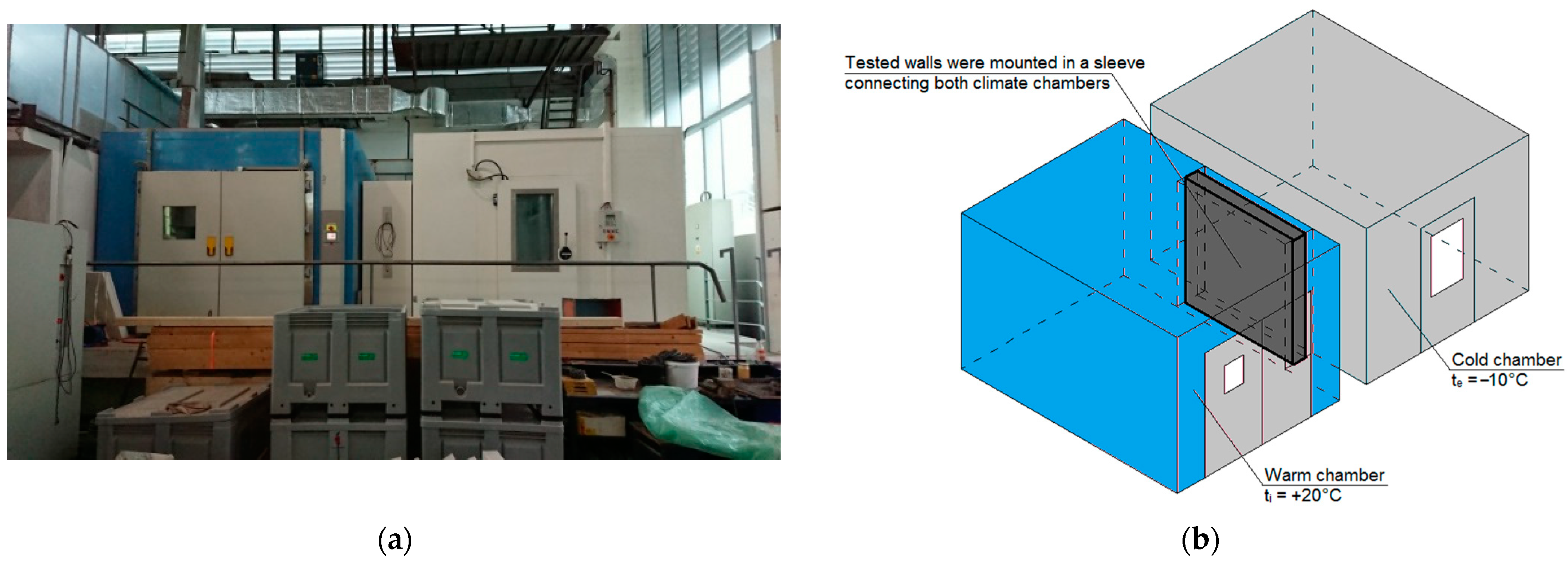
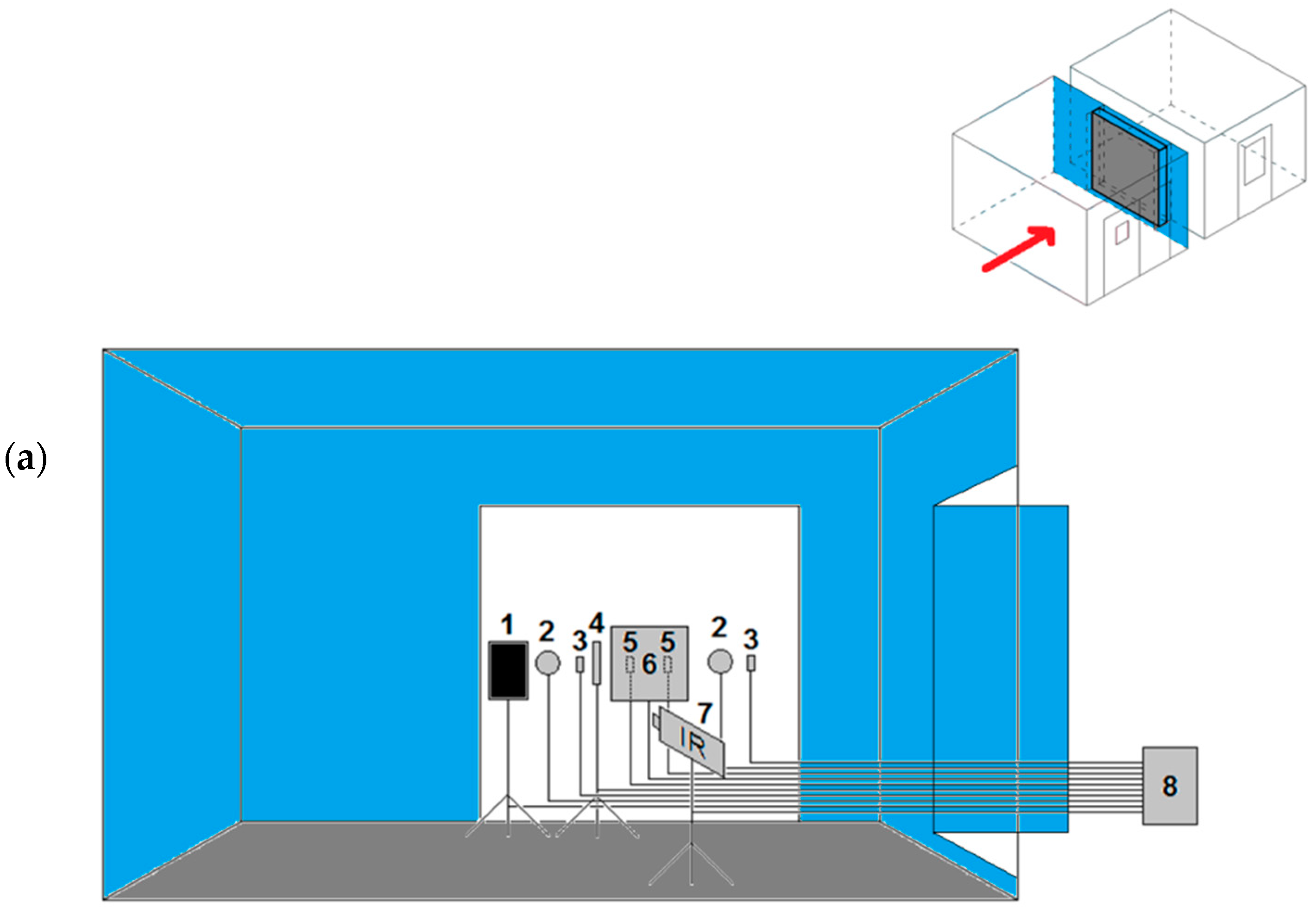
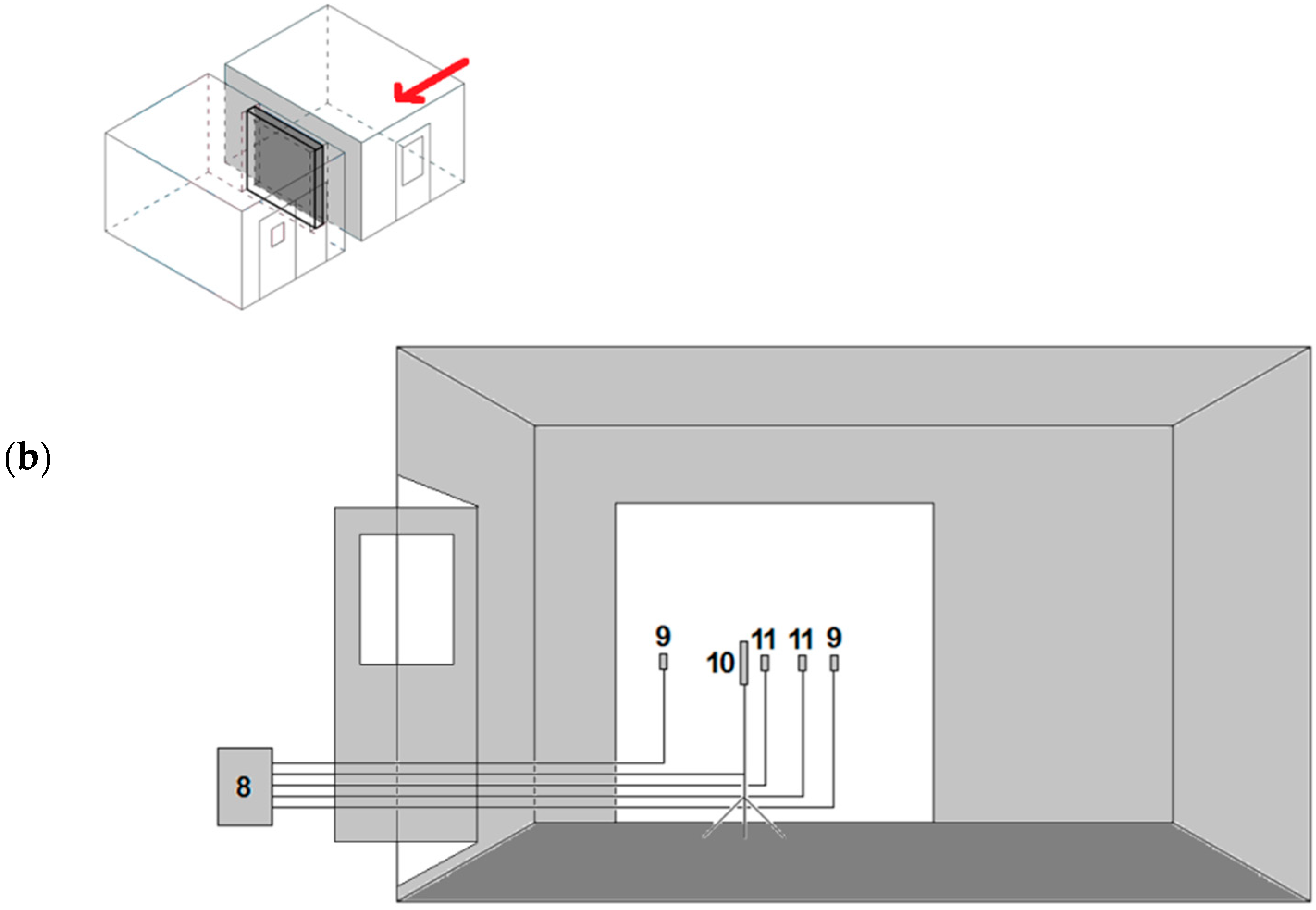
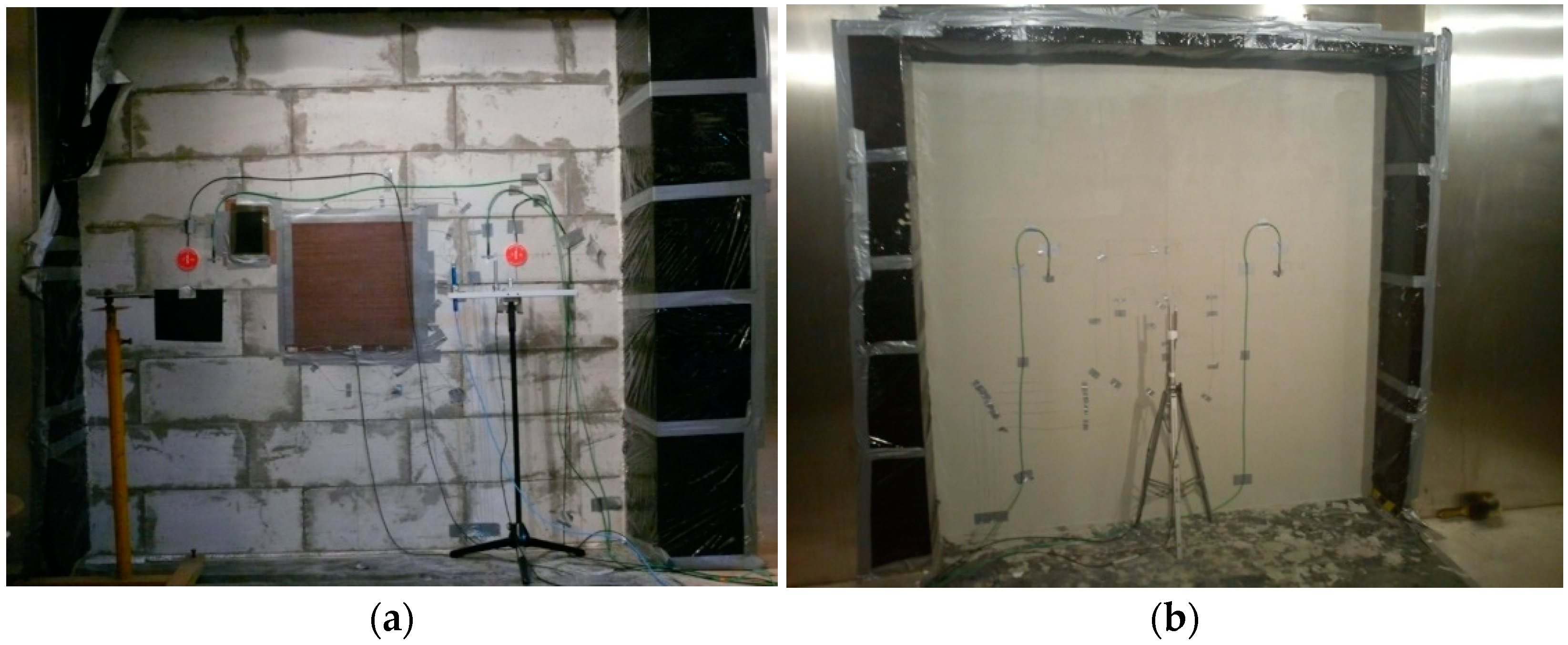
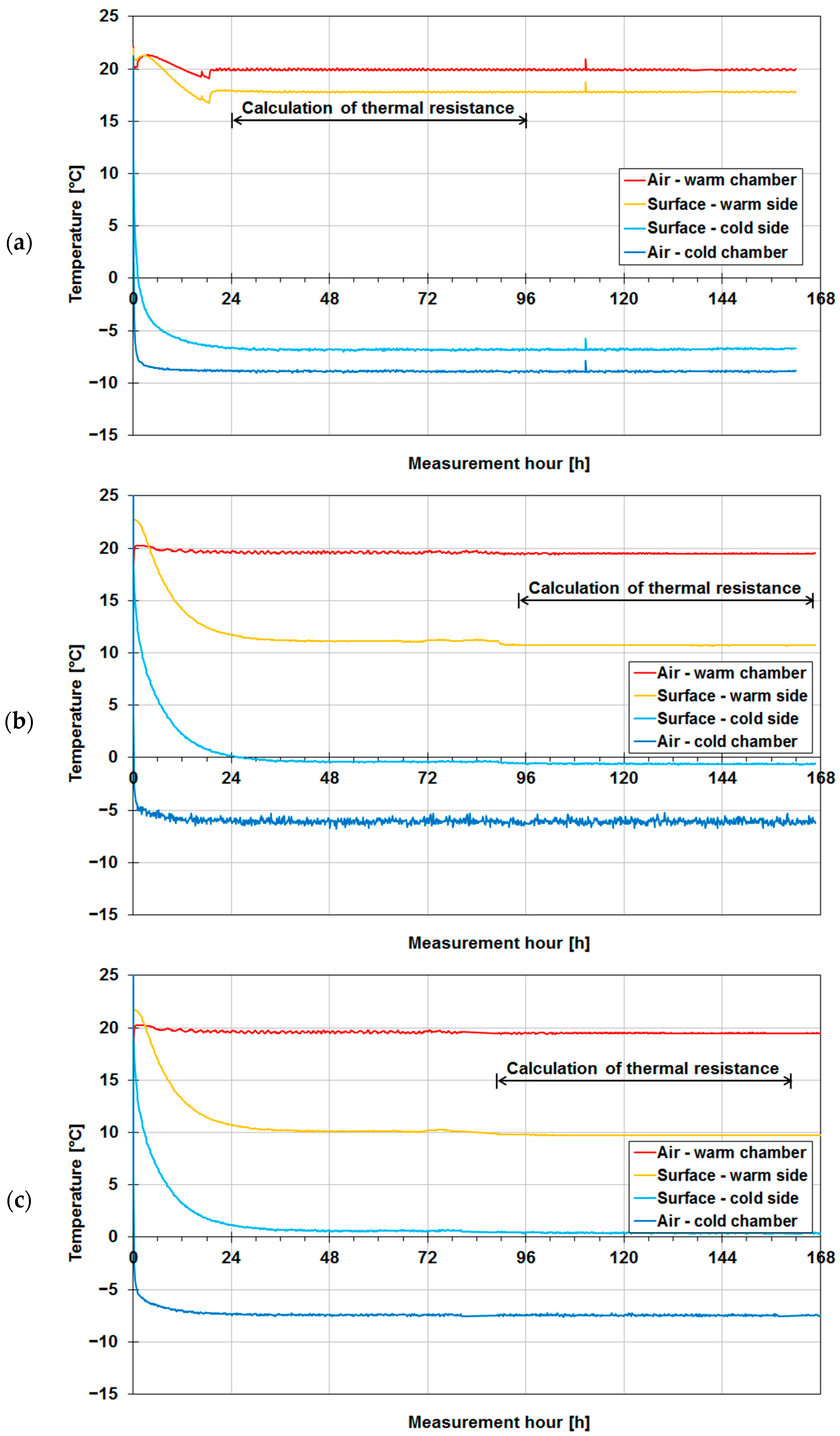

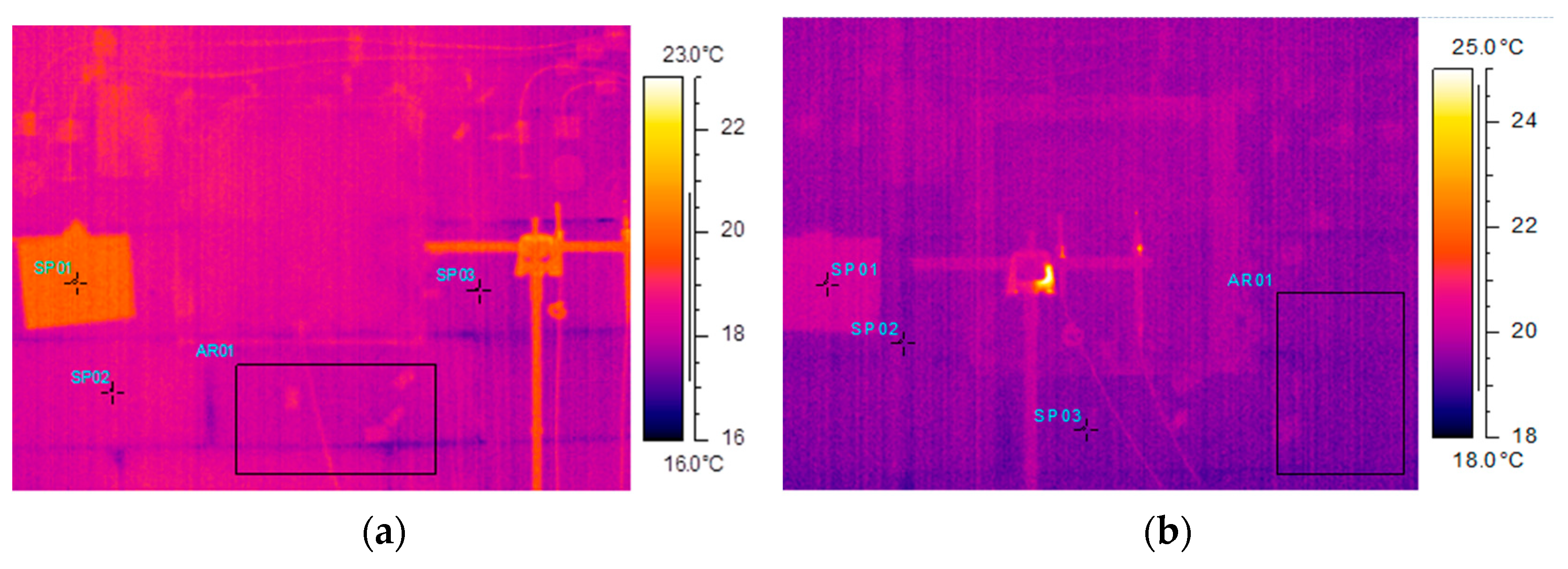
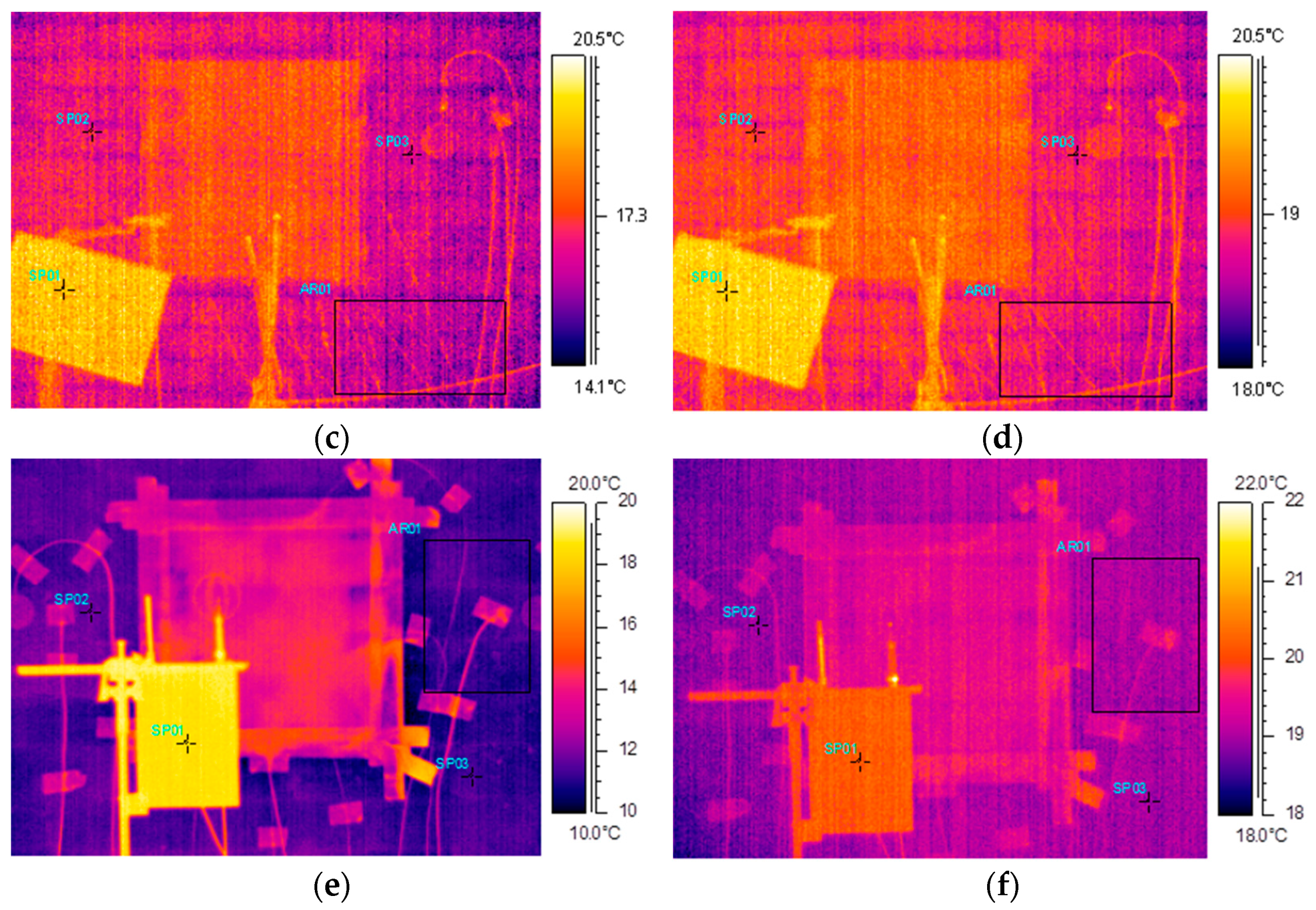


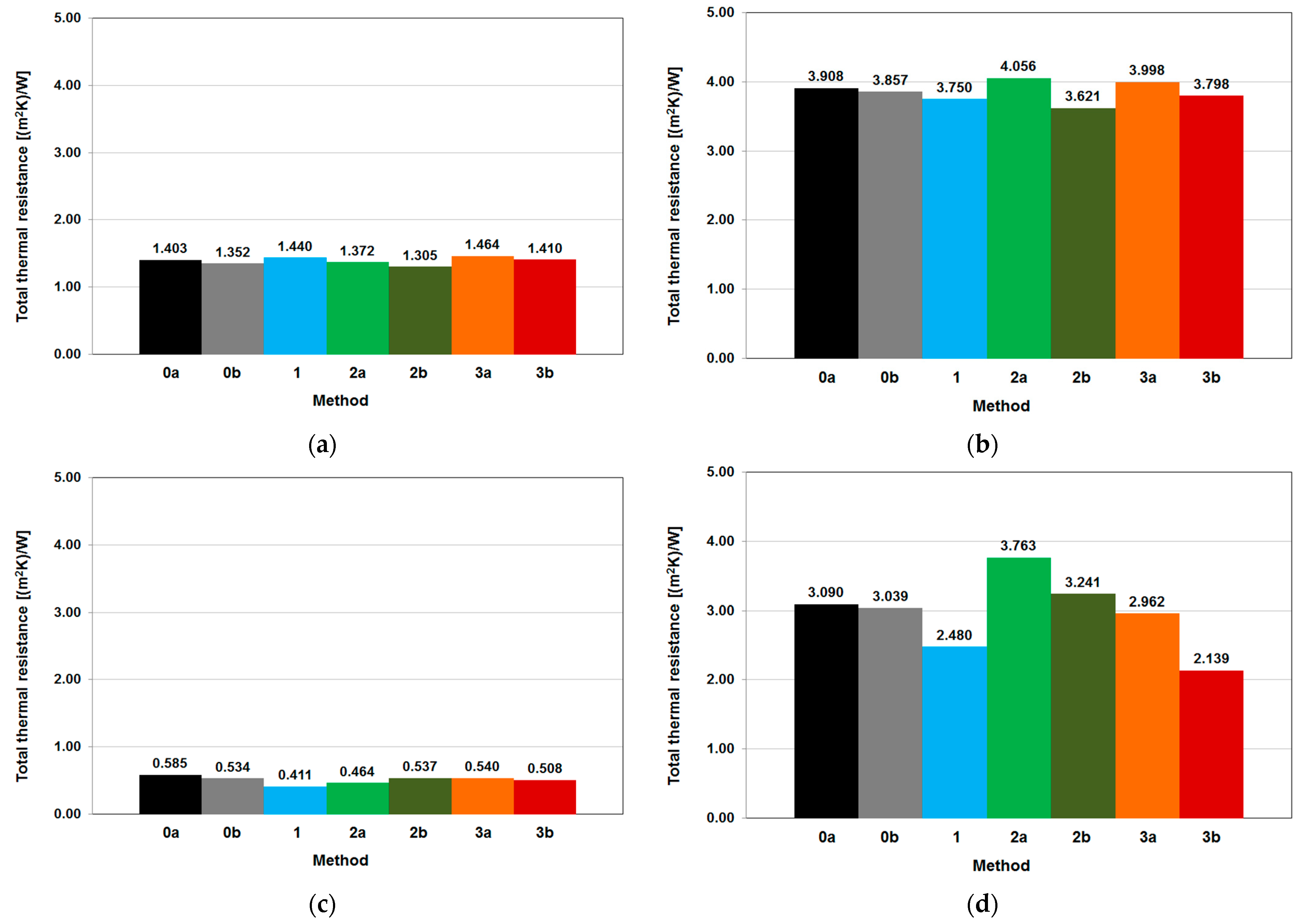
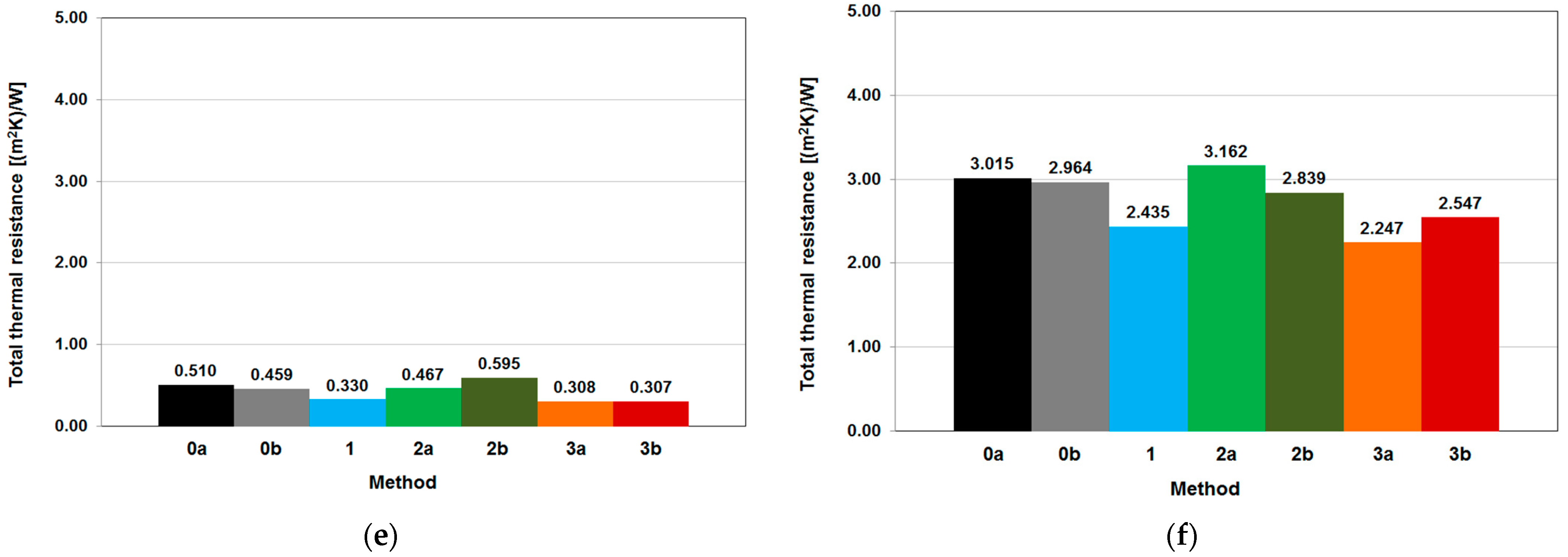
| Test Object | Material, Thickness (Innermost Layer First) | Declared Thermal Conductivity | Calculated R-Value |
|---|---|---|---|
| W/mK | m2K/W | ||
| Wall A | Aerated concrete blocks, 24 cm | 0.210 * | 1.313 |
| Wall A (insulated) | Aerated concrete blocks, 24 cm | 0.210 * | 3.818 |
| EPS boards, 10 cm | 0.040 ** | ||
| Fiberglass mesh-reinforced mineral render, 0.5 cm | 1.000 *** | ||
| Wall B | Solid ceramic brick, 25 cm | 0.770 *** | 0.495 |
| Wall B (insulated) | Solid ceramic brick, 25 cm | 0.770 *** | 2.999 |
| EPS boards, 10 cm | 0.040 ** | ||
| Fiberglass mesh-reinforced mineral render, 0.5 cm | 1.000 *** | ||
| Wall C | Concrete blocks, 25 cm | 1.000 *** | 0.420 |
| Wall C (insulated) | Concrete blocks, 25 cm | 1.000 *** | 2.925 |
| EPS boards, 10 cm | 0.040 ** | ||
| Fiberglass mesh-reinforced mineral render, 0.5 cm | 1.000 *** |
| Method of Determining Thermal Resistance of Building Enclosure | Rsi | R | Rse | Rtot | ||
|---|---|---|---|---|---|---|
| Name | Type | Description | m2K/W | m2K/W | m2K/W | m2K/W |
| 0a | computational | Calculation using material data according to ISO 6946 | ISO 6946, Table 7 (Section 2.3.1) | (Section 2.1) | ISO 6946, Table 7 (Section 2.3.1) | |
| 0b | computational + measurement | Calculation using material data according to ISO 6946 + measurement of air movement velocity | ISO 6946, Appendix A (Section 2.3.2) | (Section 2.1) | ISO 6946, Appendix A (Section 2.3.2) | |
| 1 | measurement | Measurement of air and wall surface temperatures and air movement velocity by thermocouples | ISO 6946, Appendix A (Section 2.3.2) | - | ISO 6946, Appendix A Section 2.3.2) | where: (Section 2.2.1) (Section 2.2.1) |
| 2a | measurement | Measurement of air and wall surface temperatures by thermocouples and heat flux density (Ahlborn sensors) | (Section 2.3.3) | (Section 2.2.2) | (Section 2.3.3) | |
| 2b | measurement | Measurement of air temperatures by thermocouples and wall surface temperatures and heat flux density by dedicated device (Hukseflux TRSYS01) | ISO 6946, Appendix A (Section 2.3.2) | where: R1 and R2 are results of measurement by dedicated device | ISO 6946, Appendix A (Section 2.3.2) | |
| 3a | measurement | Spot measurement of air and surface temperatures on warm side by IR camera, on cold side by thermocouples | ISO 6946, Appendix A (Section 2.3.2) | - | ISO 6946, Appendix A (Section 2.3.2) | (Section 2.2.1) |
| 3b | measurement | Area measurement of air and surface temperatures on warm side by IR camera, on cold side by thermocouples | ISO 6946, Appendix A (Section 2.3.2) | - | ISO 6946, Appendix A (Section 2.3.2) | (Section 2.2.1) |
| Method of Determining Surface Thermal Resistances | Rsi | Rse |
|---|---|---|
| m2K/W | m2K/W | |
| Computational—ISO 6946, Table 7 (Section 2.3.1) | 0.130 | 0.130 |
| Computational + measurement—ISO 6946, Appendix A | 0.088 | 0.121 |
| Measurement—Wall A | 0.101 | 0.099 |
| Measurement—Wall B | 0.159 | 0.100 |
| Measurement—Wall C | 0.169 | 0.136 |
| Measurement—Wall A (insulated) | 0.083 | 0.153 |
| Measurement—Wall B (insulated) | 0.214 | 0.134 |
| Measurement—Wall C (insulated) | 0.132 | 0.139 |
| Measurement—mean value | 0.143 | 0.127 |
| Test Object | Temperature Measurements by Infrared Camera | ||||||||
|---|---|---|---|---|---|---|---|---|---|
| Air (SP01) | Surface (SP02, SP03) | Surface (AR01) | |||||||
| Min °C | Max °C | Mean °C | Min °C | Max °C | Mean °C | Min °C | Max °C | Mean °C | |
| Wall A | +19.8 | +20.2 | +20.0 | +17.9 | +18.6 | +18.3 | +18.2 | +18.2 | +18.2 |
| Wall B | +19.9 | +20.3 | +20.1 | +15.5 | +16.0 | +15.7 | +15.3 | +15.5 | +15.4 |
| Wall C | +18.4 | +20.3 | +19.1 | +11.0 | +12.5 | +11.6 | +11.5 | +11.6 | +11.5 |
| Wall A (insulated) | +19.6 | +20.2 | +20.0 | +19.2 | +19.7 | +19.4 | +19.2 | +19.4 | +19.3 |
| Wall B (insulated) | +20.3 | +20.5 | +20.4 | +19.4 | +19.7 | +19.5 | +19.1 | +19.3 | +19.2 |
| Wall C (insulated) | +19.9 | +20.3 | +20.2 | +18.9 | +19.2 | +19.0 | +19.1 | +19.2 | +19.2 |
| Method of Determining Total Thermal Resistance | Total Thermal Resistance, Rtot m2K/W | |||||
|---|---|---|---|---|---|---|
| Wall A | Wall B | Wall C | Wall A (Insulated) | Wall B (Insulated) | Wall C (Insulated) | |
| 0a | 1.403 | 0.585 | 0.510 | 3.908 | 3.090 | 3.015 |
| 0b | 1.352 | 0.534 | 0.459 | 3.857 | 3.039 | 2.964 |
| 1 | 1.440 | 0.411 | 0.330 | 3.750 | 2.480 | 2.435 |
| 2a | 1.372 | 0.464 | 0.467 | 4.056 | 3.763 | 3.162 |
| 2b | 1.305 | 0.537 | 0.595 | 3.621 | 3.241 | 2.839 |
| 3a | 1.464 | 0.540 | 0.308 | 3.998 | 2.962 | 2.247 |
| 3b | 1.410 | 0.508 | 0.307 | 3.798 | 2.139 | 2.547 |
| Average | 1.392 | 0.511 | 0.425 | 3.855 | 2.959 | 2.744 |
| Standard deviation | 0.050 | 0.053 | 0.104 | 0.138 | 0.486 | 0.313 |
| Max–Min | 0.159 | 0.173 | 0.288 | 0.435 | 1.624 | 0.915 |
| Relative range (from average) | −6.2% to +5.2% | −19.5% to +14.3% | −27.8% to +40.0% | −6.1% to +5.2% | −27.7% to +27.2% | −18.1% to +15.2% |
| Method of Determining Thermal Resistance | Difference between Given Method and Mean Value (Rtot,k—Rtot,mean) m2K/W (+ Above Mean, − Below Mean) % (Absolute Value) | ||||||
|---|---|---|---|---|---|---|---|
| Wall A | Wall B | Wall C | Wall A (Insulated) | Wall B (Insulated) | Wall C (Insulated) | Average (Without One Worst Result) | |
| 0a | +0.011 | +0.073 | +0.085 | +0.052 | +0.130 | +0.271 | - |
| 0.8 | 14.3 | 19.9 | 1.4 | 4.4 | 9.9 | 6.1 | |
| 0b | −0.040 | +0.023 | +0.034 | +0.002 | +0.080 | +0.220 | - |
| 2.9 | 4.4 | 8.0 | 0.0 | 2.7 | 8.0 | 3.6 | |
| 1 | +0.048 | −0.100 | −0.096 | −0.106 | −0.479 | −0.309 | - |
| 3.4 | 19.5 | 22.5 | 2.7 | 16.2 | 11.3 | 10.6 | |
| 2a | −0.021 | −0.047 | +0.042 | +0.201 | +0.804 | +0.418 | - |
| 1.5 | 9.2 | 9.9 | 5.2 | 27.2 | 15.2 | 8.2 | |
| 2b | −0.087 | +0.026 | +0.170 | −0.234 | +0.282 | +0.095 | - |
| 6.2 | 5.0 | 40.0 | 6.1 | 9.5 | 3.4 | 6.1 | |
| 3a | +0.072 | +0.029 | −0.117 | +0.142 | +0.003 | −0.497 | - |
| 5.2 | 5.6 | 27.5 | 3.7 | 0.1 | 18.1 | 6.5 | |
| 3b | +0.018 | −0.004 | −0.118 | −0.057 | −0.820 | −0.198 | - |
| 1.3 | 0.7 | 27.8 | 1.5 | 27.7 | 7.2 | 7.7 | |
Publisher’s Note: MDPI stays neutral with regard to jurisdictional claims in published maps and institutional affiliations. |
© 2021 by the authors. Licensee MDPI, Basel, Switzerland. This article is an open access article distributed under the terms and conditions of the Creative Commons Attribution (CC BY) license (https://creativecommons.org/licenses/by/4.0/).
Share and Cite
Nowak, H.; Nowak, Ł. Non-Destructive Possibilities of Thermal Performance Evaluation of the External Walls. Materials 2021, 14, 7438. https://doi.org/10.3390/ma14237438
Nowak H, Nowak Ł. Non-Destructive Possibilities of Thermal Performance Evaluation of the External Walls. Materials. 2021; 14(23):7438. https://doi.org/10.3390/ma14237438
Chicago/Turabian StyleNowak, Henryk, and Łukasz Nowak. 2021. "Non-Destructive Possibilities of Thermal Performance Evaluation of the External Walls" Materials 14, no. 23: 7438. https://doi.org/10.3390/ma14237438






